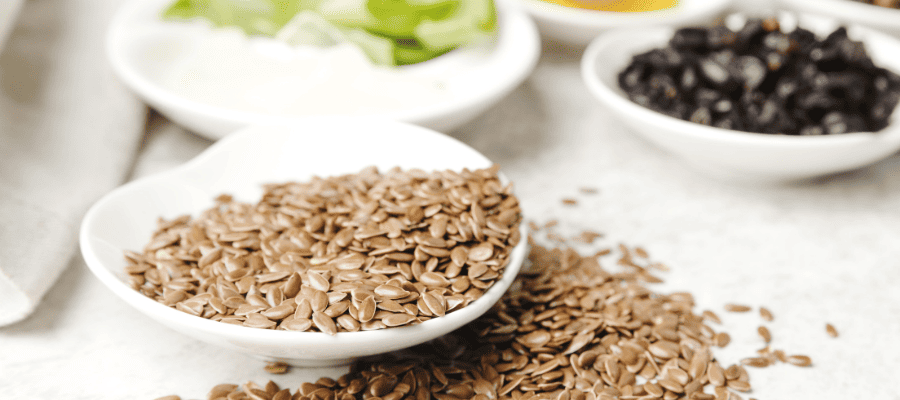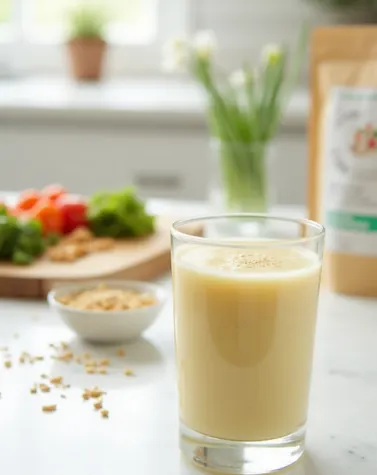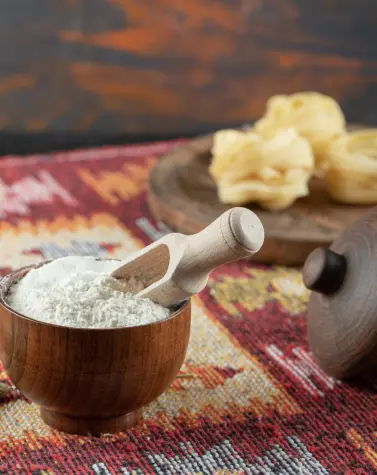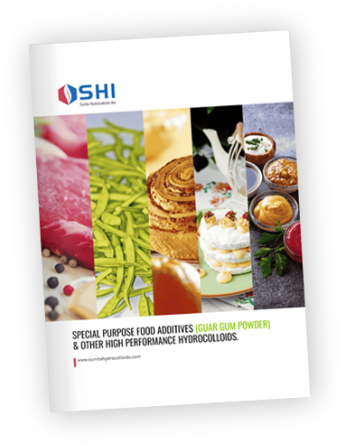
Top 10 Xanthan Gum Alternatives for Your Recipes
If you’ve ever wondered why you need xanthan gum in your cooking, you are not alone! Xanthan gum is a go to ingredient that works as a binder and thickener that helps create the structure which gluten normally gives. However, some people get digestive troubles using it or just want more natural options. The good news is that many substitutes actually exist and most of them work just as good – if not better – for some recipes.
From plant-based binders to fiber-rich thickeners, this guide looks at the top 10 alternatives to xanthan gum, and how you can use them in your kitchen right now.

1. Guar Gum
Best used for: Baked goods, sauces, dressings
Substitution Ratio: 1:1 with xanthan gum
Guar gum is the most common and direct substitute for xanthan gum. It comes from guar beans and is a natural soluble fiber with strong thickening power. It works well in cold and hot dishes and is especially good in gluten-free baking.
To use: Mix with dry ingredients first to prevent clumping. Use 3 parts guar gum for every 2 parts xanthan gum in a recipe.
2. Chia Seeds
Best used for: Muffins, pancakes, puddings
Substitution Ratio: 1 tbsp chia + 3 tbsp water = 1 egg or 1 tsp xanthan gum
Have you ever made chia pudding? Then you may be familiar with how these tiny seeds create a jelly coating when soaked in liquid. Well that jelly layer is what is going to help stabilize your baked goods when you switch xanthan gum out for chia seeds in your recipe. They are also packed with Omega-3s and fiber which adds a nutritional balance to your baking.
To use: Combine 1 tbsp ground chia seeds with 3 tbsp water and soak them for 10-15 minutes before you add it to your recipe.
3. Ground Flax Seeds
Best used for: Breads, muffins, dense cakes
Substitution Ratio: 1 tbsp flax + 3 tbsp water = 1 egg or 1 tsp xanthan gum
Similar to how you would use chia seeds to stabilize your baked goods, ground flax helps thicken and bind your ingredients together as well.
For some people, flax seeds are more common than chia in their pantry. They give wonderful structure and moisture in baked goods. But be aware that using ground flax instead of xanthan gum can add a slightly nutty flavor and grainy texture to your baking.
To use: Stir together 1 tbsp ground flaxseed with 3 tbsp hot water. Let it soak for about 10 minutes before using.
4. Psyllium Husk
Best used for: Breads, pizza dough, wraps
Substitution Ratio: 1 tsp xanthan gum = 2 tsp psyllium husk powder
Psyllium husk is a versatile ingredient in the kitchen. It functions as a thickener and emulsifier (binder). So having this in your pantry can definitely save a recipe that needs xanthan gum when you don’t have it.
Another benefit to psyllium husk is that it is high in fibre. A study conducted actually proved its effectiveness! Scientists wanted to increase the fiber content in bread. In their experiments, they added 5% psyllium husk powder to their flour blend. The results were completely unexpected! Not only did the bread rise higher, it also kept more moisture and had more volume overall.
To use: Add ½ tsp at a time. Wait for thickening and then add more if needed. Too much can create a gummy texture.
5. Cornstarch
Best used for: Sauces, gravies, custards
Substitution Ratio: 1 tbsp cornstarch = 1 tsp xanthan gum
Cornstarch can be found in most households and is easy to find at the local supermarket. But besides being easy to find, cornstarch is an exceptionally good gluten-free thickener and probably the most commonly used gluten free ingredient.
While it doesn’t have the binding strength of xanthan gum in baking, it’s great for thickening soups and sauces.
Though a cold slurry, cornstarch and water will not stay mixed together, but once added to a recipe and cooked, they will.
To use: Make a slurry by combining 1 tbsp cornstarch + 1 tbsp cold water and mixing the two ingredients together well. Stir into your hot liquid to avoid lumps and allow to cook until thickened.
6. Tapioca Flour (Tapioca Starch)
Best used for: Pies, cookies, batters
Substitution Ratio: 2 tbsp tapioca = 1 tsp xanthan gum
Extracted from cassava root, tapioca flour provides chewy texture and shine to your baked goods. It’s frequently used in paleo and gluten-free baking and helps improve moisture.
In gluten free baking, tapioca flour can be a wonderful binder that “glues” everything together and also gives a tender but structured texture.
To use: Combine with other flours for best structure in baked goods. You may need to experiment with amounts since tapioca can make things more elastic than xanthan gum.
Professional tip: Tapioca flour works especially well in recipes that need a bit of stretch and chew, like pizza crusts and breads.
7. Arrowroot Powder
Best used for: Puddings, jellies, clear sauces
Substitution Ratio: 2 tbsp arrowroot = 1 tsp xanthan gum
Arrowroot can be a great xanthan gum alternative in a pinch. It is flavorless fine powder made by grinding up the root of arrowroot plant.
It’s a gluten-free starch that thickens at lower temperatures and creates a smooth, glossy finish. This is a great option for those avoiding corn-based thickeners.
Since it’s starchy with no strong flavor, arrowroot is one of the popular gluten-free flours in gluten free baking. It also helps create the structure that is so needed in baking without gluten.
To use: Use 1 tbsp arrowroot for every 1 tsp xanthan gum. Keep in mind that arrowroot breaks down with extended cooking, so don’t overheat.
8. Agar Agar
Best used for: Gels, jellies, vegan desserts
Substitution Ratio: 1 tsp agar powder = 1 tsp xanthan gum (in some recipes)
Agar agar is a great option for replacing xanthan gum when you need a stabilizer. It is a vegan gelatin substitute made from seaweed. It is derived from cell walls of red algae and acts as a thickener and stabilizer.
It forms a gel-like substance when mixed with water. While it is better suited for setting rather than thickening, it can mimic texture of xanthan gum in some desserts.
In gluten-free baking, this would result in a stretchier dough, chewier breads and (more) moist cakes. That said, keep in mind that using too much agar agar can result in excess moisture being retained.
To use: Dissolve as instructed on the package and then use the dissolved agar agar at a 1:1 ratio for the xanthan gum in a recipe. Requires boiling to activate its gelling properties.
9. Egg Whites
Best used for: Muffins, cakes & pancakes (non-vegan recipes)
Substitution Ratio: 1 egg = 1 tsp xanthan gum
Egg whites are a great binding and rising agent which is why they are used in many baking recipes. They can give moisture and a light texture to whatever you are baking.
Since egg whites are such a good binder option, they are an excellent choice to prevent baked goods from having a dry and crumbly texture that no one wants to end up with.
But keep in mind that egg whites may change the texture of your crumb and they are not vegan friendly.
To use: 1 egg white will replace 1 tsp of xanthan gum. Use eggs in combination with a starch like tapioca or cornstarch for better structure.
10. Yogurt
Best used for: Quick breads, muffins & pancakes
Substitution Ratio: ¼ cup yogurt = 1 egg or 1 tsp xanthan gum
Yogurt provides moisture and binding power in baking. It’s not suitable for all recipes, but can be a flavorful alternative when a slight tang is welcome. The moisture in yogurt helps create the structure that gluten-free baking needs so much.
To use: Use plain, full-fat yogurt for best consistency. Add directly to your wet ingredients when mixing.
Recipe Considerations
Before substituting xanthan gum, consider:
- Purpose: Are you thickening, binding, or stabilizing?
- Recipe type: Is it bread, cake, or sauce?
- Dietary needs: Are you avoiding animal products, corn, or processed foods?
Different substitutes perform differently depending on the application, so experimenting with combinations and quantities is key.
Common Substitution Mistakes
Using too much: Can cause gummy, unpleasant textures
Not mixing properly: Some ingredients clump or separate
Ignoring the recipe’s purpose for xanthan gum: Leads to structural failures
Always start with small amounts and adjust based on your results.
Substitution Ratios at a Glance
| Substitute | Amount to Replace 1 tsp Xanthan Gum |
| Guar Gum | 1 tsp |
| Chia Seeds (gel) | 1 tbsp chia + 3 tbsp water |
| Ground Flax (gel) | 1 tbsp flax + 3 tbsp water |
| Psyllium Husk | 2 tsp (powdered) |
| Cornstarch | 1 tbsp |
| Tapioca Flour | 2 tbsp |
| Arrowroot Powder | 2 tbsp |
| Agar Agar | 1 tsp (powder, cooked) |
| Egg (non-vegan) | 1 whole egg |
| Yogurt (non-vegan) | ¼ cup |
Conclusion
Xanthan gum is a helpful tool in modern gluten-free and allergy-friendly cooking—but it’s far from the only one. With alternatives like guar gum, chia seeds, psyllium husk, and flax, you can still achieve delicious texture, structure, and stability in your recipes.
Whether you’re baking muffins, thickening a soup, or crafting a gluten-free bread loaf, there’s an ideal substitute out there. With some experimentation and the right ratios, you can find the perfect xanthan gum replacement to suit your dietary needs and culinary goals.





